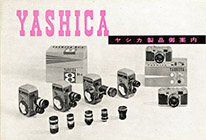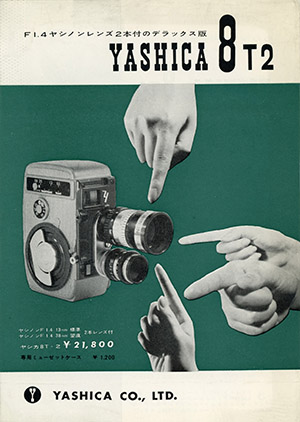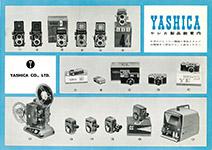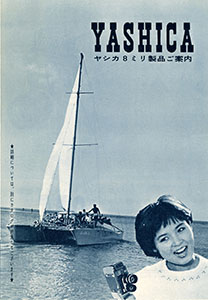Yashica 8, 8S, 8T & 8T-2
and the rest of the 8 mm movie cameras
Contents
(Scroll down or click on Links)
The Importance of the Yashica 8 Movie Camera
Yashica 8 Camera
Yashica 8S, 8T & 8T-2 Cameras
Serial Numbers
Lenses
Yashica 8P Projector & 8PE Editor
Yashica 8 mm Movie Cameras that Followed
Models Mounting Lenses Other then Yashica Yashinon
Yashica 8T3 (aka T3), Another Zunow Connection
Yashica 8 EC with Zeika Lens
Yashica 8M with both Yashikor & Zunow Lenses
Yashica AIII, a Lens Oddity
Yashica 8-ES, a Camera Oddity
The Umatics, the Pride of the Fleet
The Importance of the Yashica 8 Movie Camera
The Yashica 8 was far more significant than just the first product in a new market segment for the company. It signalled that Yashima was about to evolve from being a solely TLR reliant company to becoming a significant player across the spectrum of camera types, formats and related accessories. It also signalled that it was willing to work with lens companies other than Tomioka, in this case Zunow Optical Industry Co., Ltd.
Whether Yashima had any development assistance for the camera body is unknown but certainly, Yashica 8 production would have introduced new skills, capabilities and capacity that would enable the company to undertake its forays into other market areas. Design wise, I think that Yashima took a very close look at the Swiss made Bolex B8 released in 1953:

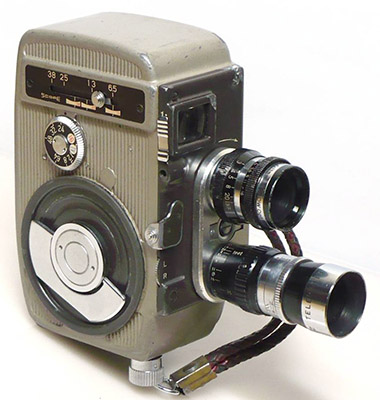
(From larger web images)
The biggest difference is that the zoom viewfinder is operated by a dial on the B8 and a slider on the Yashica 8. Note, even the release trigger is similar, modified on the later 8S, 8T and 8T-2 models but then the 8T and 8T-2 adopted the more B8-like viewfinder surround with branding alongside. The Yashica example is fitted with a non-standard Walz telephoto.
Yashica 8 Camera
The Yashica 8 is a typical home movie camera of the time. Feature wise it is basic but it is well built with a die-cast aluminium body and good quality for its positioning. It uses standard 8, also known as double 8, cine film. This is 16 mm cine film with twice as many sprocket holes down either side as “normal” 16 mm for use in 16 mm cameras. Only half the width of the film is exposed when run through the camera. The length of film is about 25 feet and when the end is reached, the camera is opened and the film spools flipped top to bottom and then the other half width of film can be used. After processing, the film is split and spliced together giving a total length of about 50 feet, or about 4 minutes of viewing time.
As common at the time, the Yashica 8 was powered by a spring driven clockwork motor. With a fully wound spring, running time was about 30 seconds. The normal shooting frame rate was 16 frames per second but the camera was capable of a number of frame rates from 8 to 64 frames per second. The viewfinder could zoom from a wide angle of 6.5 mm to telephoto length of 38 mm to match the lens in use - the normal length for the format was 13 mm.
The release date of the Yashica 8 movie camera is quoted as either 1957 (Camera-wiki.org) or claimed to be 1958 at Photokina in Germany. As far as I can tell, both dates are perhaps correct, depending on perspective. From my research, Yashica did release the “Yashica 8” in 1957 but probably only in Japan. There is a range of serial numbers in my database which almost certainly pre-date “date code” numbers which so far start in January 1958 but in any case, the company's 1975 booklet, “Yashica A New Horizon”, tells us that it was September 1957 (the booklet says 8T-2 but from Yashica's own brochures from the time, it is clearly an error, it was the “Yashica 8”, the 8T-2 being a 1958 release). It had a turret lens mount, and possibly because of the booklet, many commentators today already refer to it as the “Yashica 8T” but in fact, that name came later with the updated model further below. It came standard with one lens fitted, a Zunow 13mm f/1.9. Both Zunow 38mm f/1.9 and 6.5mm f/1.9 lenses were supplied by Yashica as optional accessories. Below are left and right side views. Note the film door latch, viewfinder moulding, sliding switch on the side of the viewfinder, shutter release pad on front, shutter lock thumb wheel and turret pivot detailing, all of which are different to models commonly found in the west:
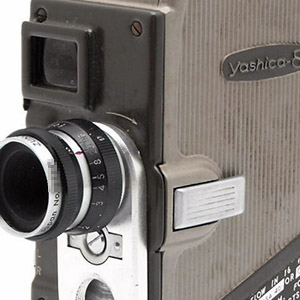
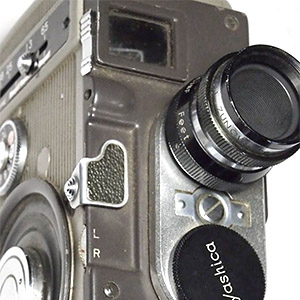
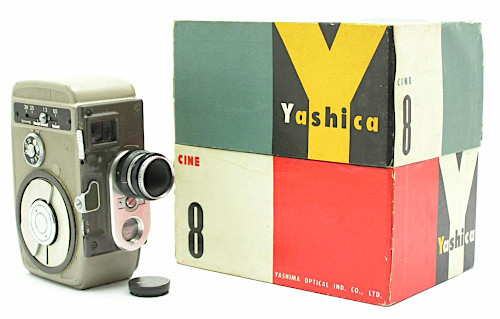
(Detail from larger web images)
I know that they are earlier because of the serial numbers, they all identify “Yashima” as the maker, instead of “Yashica” (the changeover of the company name on cameras occurred in September 1958) whereas either can be found on the later variants and they all have the serial number inside whereas the later variants mostly have it outside on the door (the first examples are still inside).
Yashica 8S, 8T & 8T-2 Cameras
New models featuring a stylised “Y” cast into the front panel, under the lens on the single lens mount model and next to the viewfinder on the turret models, seem to have started production in May-June 1958 and production of the earlier Yashica 8 abruptly ceased in June. There must have been plenty of inventory as both earlier and later models were featured together in the two Japanese brochures linked further below. This is part of a page from the brochure just below which confirms the earlier and later model names and highlights some of the differences (note, “Zunow” can be seen on one of the Yashica 8's lenses on the left):

(Brochure scan courtesy of Chris Whelan)
Note, the left Yashica 8 panel shows two lenses mounted. As suggested by the pricing, it was sold with one lens mounted, the other, wide angle and/or telephoto, was available as an accessory item. The Zunow telephoto upper lens shown in the upper position was available for 6,800 yen which would make the total price 22,300 yen, so effectively the same as the 8T-2 with a small discount for the second lens included as standard with the latter camera.
This brochure, issued 10 September 1958, is the source of the above page and features Japanese market Yashica cameras, including cine cameras, accessories and both Yashinon and Zunow lenses:
The updates also brought a change in colour:
 (Detail from larger web image)
(Detail from larger web image)
Photokina 1958
As noted earlier, several sources refer to the Yashica 8 being released at Photokina. The website Anna & Terry Vacani Binocular & Cine Collection more specifically claims that the camera debuted at Photokina in July 1958 with two models offered; the single lens “Yashica 8S” and the twin lens “Yashica 8T2” (stet). Clearly, Photokina was a world debut of both the new models and the Yashica 8 movie camera product in the generic sense. In Japan however, the “Yashica 8” model had been in production since 1957 and was now superceded.
Yashica 8S
The single lens “Yashica 8S” was now without turret. Even though production seems to have started simultaneously with the new turret versions, it oddly doesn't feature in the early Japanese brochures. The earlier standard Zunow 13mm f/1.9 had morphed into the same spec Yashikor fitted to this model and advertised with the 1960 Yashica 8M only (early 8M example found with Yashikor, eight later 8Ms are fitted with the same spec Zunows). A Japanese blog site has compared a Zunow Cine f/1.9 13 mm lens to the same spec Cine Yashikor and at least the barrels are identical (can be seen with the two Zunows above and the Yashikor immediately below - note two of the lenses have the removable front black rings fitted, short shades, one doesn't).
 (Detail from larger web image)
(Detail from larger web image)
Yashica 8T & 8T-2
As well as the differences with the Yashica 8 (most obviously with shutter release, viewfinder and door latch) noted above, the new twin lens version features upgraded 13mm f/1.4 and 38mm f/1.4 lenses now called “Cine Yashinon”:
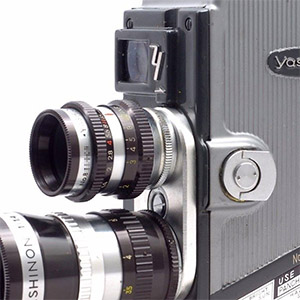
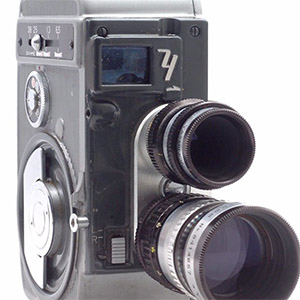 (Detail from larger web images)
(Detail from larger web images)
According to the above brochure, which features both the earlier “Yashica 8” and the later camera (referred to as a “luxury” version), it came with both lenses fitted and was called the “Yashica 8T-2”. I have photos of otherwise identical boxes marked with both “Yashica 8T-2” and “with two lenses” and “Yashica 8T” and “with one lens” (Yashinon 13mm f/1.4 lens still mounted on the turret) - I am not sure if one arrived first or both were released together.
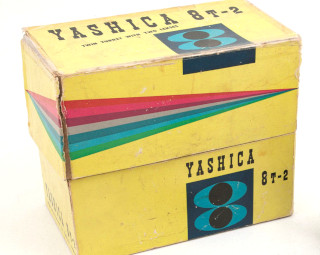
.jpg)
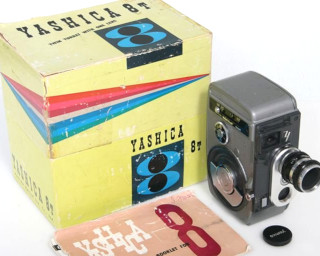
.jpg)
(Web images)
Note, Yashica was entirely inconsistent with its naming, sometimes the Yashica 8T-2 was called the “8T-2”, as on the presentation box, and sometimes it was the “8T2”, as on the outer box and user manual (in white, hard to see):
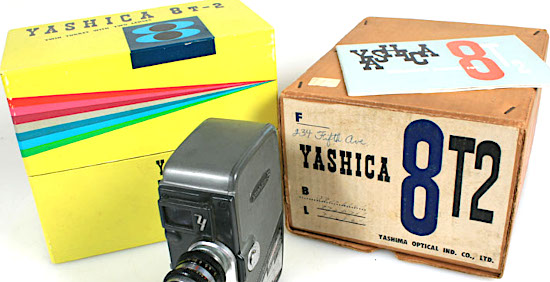 (Web image)
(Web image)
Below is a 2 page Japanese 8T-2 brochure, probably from 1958:
Serial Numbers
Date coded serial numbers were introduced in September 1957 for TLRs but not all models immediately. As noted further above, the earliest date coded camera in my Yashica 8 database is from January 1958. There are 25 Yashica 8 examples in my database of which the first 11 have non-date coded sequential numbers from 8897x to 10233x. I know that these are earlier than date coded numbers because their lens numbers are generally lower. The rest of the Yashica 8 cameras and the 47 8T-2, 8T and 8S cameras seem to mostly follow the same pattern as the TLR models with one main exception. From my serial numbers page (under “Others”):
The only divergence seems to be late 1959 numbers which seem to use a 2 digit “48” code for November and December in place of the single “4” on October examples and on all TLRs from these months. The “8” is the only number which can't be aligned to a year of either format, or mix of formats. Not quite sure about the reason or how that works but being the “Yashica 8” camera, maybe it's the model name?
The TLR format date coded serial numbers seem to work for all Yashica 8 mm models except the Yashica A III which was a special case, sharing numbers with versions sold under other brand names.
Lenses
The Japanese brochure (linked immediately above) displays a pair of accessory wide and telephoto f/1.9 “Zunow Optical Co.” cine lenses on page 12 (PDF numbering) and the same length f/1.4 Yashinons on page 11. Interestingly, the Zunows are the same price as their wider aperture Yashinon counterparts. The Yashica 8 examples featured in the brochure can be seen fitted with Zunow lenses. Whilst the Yashikor lens appears to be identical to the equivalent Zunow, I'm also inclined to believe that Zunow Cine lenses were the origin of the Yashinons. Boxed “Tele Zunow Cine” lens for Yashica (see also brochure cover photo below):
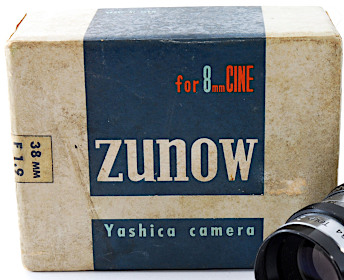
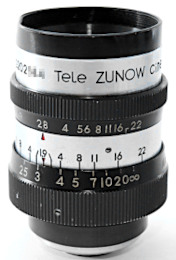 (Web images)
(Web images)
A “Yashica Scope” 2:1 Cinemascope (Yashica's description) type anamorphic accessory lens was available for all models. This would be fitted to the camera lens to optically compress the wide image and then used later on the projector lens to decompress into the wide format:
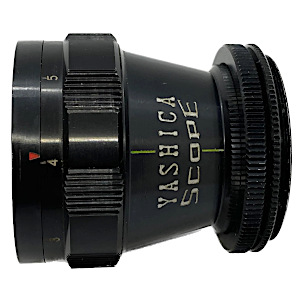
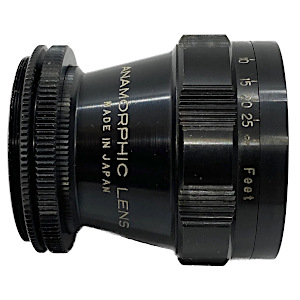
(Web images)
A special 2:1 format mask slid over the viewfinder via the slots at the top and bottom of the viewfinder:
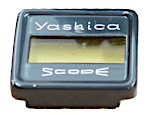 (Web image)
(Web image)
Also available was a zoom lens with range from normal (13 mm) to a moderate telephoto (38 mm). This would be mounted on the turret, or single 8S mount, and connect by bell crank to the viewfinder slider. The central pivot point for the bell crank is the hole on the side that can be seen just below the viewfinder in all models. A wheel connected through the axis of the pivot point is used for zooming and operates the lens zoom and the viewfinder concurrently. The lens is marked “Yashica Zoom Lens” but the origin is unknown (the lens on the 1959 Yashica 8 EC is also marked “Yashica Zoom Lens” but has “Zeika”, a Japanese cine lens maker name underneath). Even though the Japanese description quotes the focal length in metric, oddly for Yashica, the focal length on the lens is marked in inches (1/2" to 1 1/2") as it is for the Zeika made lens. First image is from the above linked brochure showing the zoom wheel and bell crank connections, the second and third images are of a Yashica 8S with the lens mounted and lens detail, the only one I have seen, but the bell crank is not connected and the lens is incorrectly aligned to fit the bell crank:

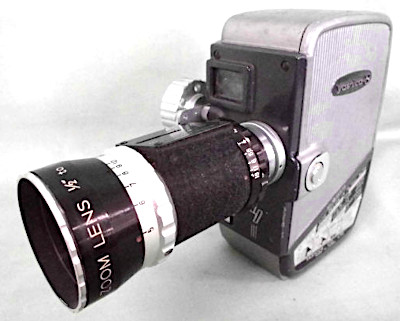
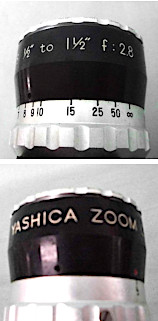
(Web images)
Note: There is/was (I can no longer find it) a statement in English Wikipedia that; “With the assistance of Tomioka Optical Works, Yashica adapted Zunow lens designs into its own 8 mm turret cine (movie) cameras.” That is total nonsense but unfortunately repeated verbatim on many other sites. The lenses are standard D mount Zunow cine lenses used on other brands as well as Yashica, e.g. Elmo and Arco (specs varied and there were minor cosmetic differences), i.e. there was nothing to adapt! The source for this claim is quoted as camera dealer Pacific Rim Camera. In fact the several source articles by Pacific Rim Camera note the lack of information about Zunow and most of the comments are based on observation and (incorrect) guesswork without any claim of factual evidence being made - the intent of the articles was to simply present the “Yashinon-V Zunow” lenses found on a triple lens turret Yashica 8T3 movie camera (advertised as “8T3, “T3” on camera), released in 1959, as something unusual and interesting. These were the standard lenses for that model and only that model, although as noted earlier, “Zunow” marked lenses are found on two other models. More further below.
Below is part of a slightly earlier 1958 Japanese Yashica brochure front cover with Zunow boxes proudly displayed. The “Yasinon” name on the Yashica boxes is found on very early Yashica 35 lenses and Yashica 8 cine lenses, more here with actual examples:
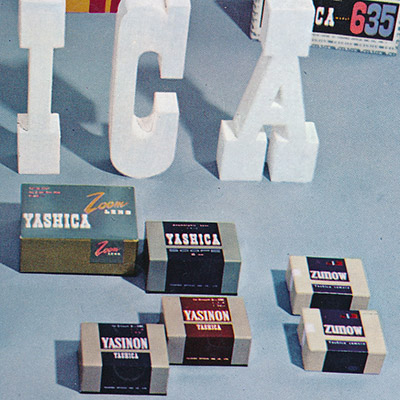 (Scan courtesy of Chris Whelan)
(Scan courtesy of Chris Whelan)
(Click on cover for PDF of full brochure with Zunow cine lenses displayed and more examples of “Yasinon” including on the front of the two new Yashica 35 cameras)
Yashica 8P Projector & 8PE Editor
After you had your processed film, there needed to be some way to view it and if you were keen, some way to edit it first. Yashica was happy to oblige with the Yashica 8P projector and Yashica 8PE film editor. Other projectors and editors followed. Note there were later editors with “8PE” in the name and the last versions were Dual 8 for both 8 mm and Super 8. I don't know when they were released but my earliest sighting is in this price list likely to be from 1959 (cameras listed are Yashica 8S, Yashica 8, Yashica 8T-2 and the 1959 Yashica EE):
Yashica 8P projector:
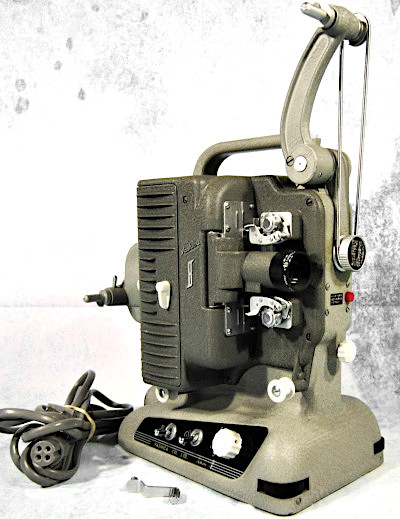
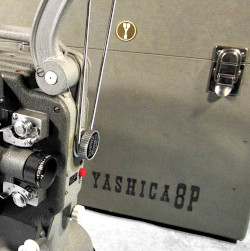
(Web images)
First type Yashica 8PE editor:
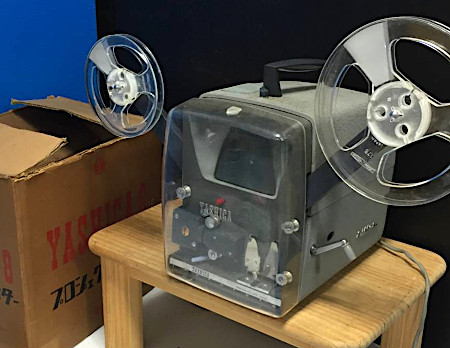 (Web image)
(Web image)
Yashica 8 mm Movie Cameras that Followed
The table below lists all the Yashica 8 mm movie cameras that I'm aware of (not including Single 8 or Super 8 models). The highlighted first models are covered above, and whilst I have found examples of all of them, the rest I haven't researched in as much detail except for some examples with other than “Yashinon” named lenses. Therefore the table should be considered as a guide rather than a statement of fact. I've seen conflicting release dates without any way of resolving them easily but in most cases, I have found cameras made in the claimed release year i have used. Nevertheless, it is possible that some of them could be out by a year or so, but generally, they should be in the ballpark.
Yashica naming practice is somewhat inconsistent. Some cameras have the name on the side and everyone accepts that, e.g. the Yashica 8-EII (although a Yashica Inc., New York, ad calls it “E3” and the Yashica EC “Zoom-8”). Some cameras have a name on the side that Yashica treats as an abbreviation, e.g. the Yashica C is called “Yashica 8C” on the box and in documentation and the Yashica M/8M is the same. Others have one name on the side and another on the front, e.g. the Yashica US has “Yashica-US” on the side and “Yashica U-matic S” below the lens. Different people have different views about which names take precedence. The names in the table are my interpretation:
| Models | Year | Lens/es | Drive | Features |
|---|---|---|---|---|
| Yashica 8 | 1957 |
Zunow |
Spring |
2 lens turret, 1 mounted |
| Yashica 8T-2 | 1958 |
Yashinon |
Spring |
2 lens turret, 2 mounted |
| Yashica 8T | 1958 |
Yashinon |
Spring |
2 lens turret, 1 mounted |
| Yashica 8S | 1958 |
Yashikor |
Spring |
Single D mount lens |
| Yashica 8T3 | 1959 |
Yashinon-V Zunow |
Spring |
3 lens turret with turret finders |
| Yashica 8-EIII | 1959 |
Yashinon |
Spring |
Auto exposure version of 8T3, different lenses |
| Yashica EE | 1959 |
Yashinon |
Spring |
Fixed prime lens, fixed focus, auto exposure |
| Yashica 8 EC | 1959 |
Zeika |
Spring |
Zoom lens & finder, manual exposure, no meter |
| Yashica 8M | 1960 |
Yashikor/ Zunow |
Battery |
2 lens turret, 1 mounted, zoom finder, manual metering |
| Yashica 8-E | 1960 |
Yashinon |
Spring |
Zoom lens, reflex finder, auto exposure |
| Yashica 8C | 1961 |
Yashinon |
Battery |
3 lens turret with turret finders, manual metering |
| Yashica U ("U-matic") | 1961 |
Yashinon |
Battery |
Zoom lens, reflex finder, auto exposure |
| Yashica AIII | 1961 |
Wizner |
Spring |
3 lens turret, zoom finder, manual metering |
| Yashica US ("U-matic S") | 1961 |
Yashinon |
Spring |
U-matic with spring drive |
| Yashica U-G ("Umatic-G") | 1962 |
Yashinon |
Battery |
Zoom lens, reflex finder, auto exposure, fixed focus, single speed |
| Yashica 8-EM | 1962 |
Yashinon |
Spring |
Zoom lens, reflex finder, auto exposure |
| Yashica U CdS ("U-matic CdS") | 1963 |
Yashinon |
Battery |
U-matic with CdS auto exposure |
| Yashica UP ("Umatic Power") | 1963 |
Yashinon |
Battery |
U-matic with power zoom, CdS auto exposure |
| Yashica 8-ES | 1963 |
Yashinon |
Battery |
Fixed prime lens, fixed focus, selenium cell auto exposure |
| Yashimat S | 1963 |
Yashinon |
Battery |
Fixed prime lens, fixed focus, Cds auto exposure |
| Yashimat Zoom | 1964 |
Yashinon |
Battery |
Zoom lens, reflex finder, CdS auto exposure |
| Yashica UL ("Umatic-L") | 1964 |
Yashinon |
Battery |
“Auto Loading Power Zoom 8”, reflex finder, CdS auto exposure |
| Yashica U5 | 1965 |
Yashinon |
Battery |
“Auto Loading Power Zoom 8”, reflex finder, CdS auto exposure |
Note 1: Where “auto exposure” or “manual metering” is mentioned without mentioning light measuring device type, it is selenium cell.
Note 2: Yashica used both “U-matic” and “Umatic” spellings on the camera front, mainly the former for earlier models and the latter for later models.
Below is a 1960 Japanese brochure featuring some of the first post 8, 8T and 8S models:
Models Mounting Other then Yashica Yashinon Lenses
We have seen that the Yashica 8 was released with Zunow lenses and that the Zunow 13 mm f/1.9 morphed into the same spec Yashikor supplied with the Yashica 8S. Both reappear on a later model and there are a couple of other odd names, one involving a bigger story.
Yashica 8T3 (aka T3), Another Zunow Connection
Named “T3” on the camera and maybe on top of its box but possibly “8T3” on the side of the box and on the cover of the user manual, it was advertised as the “8T3”:
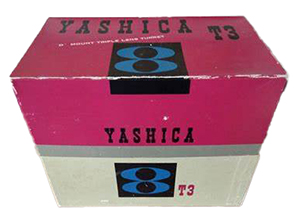
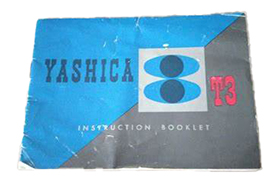 (Web images)
(Web images)
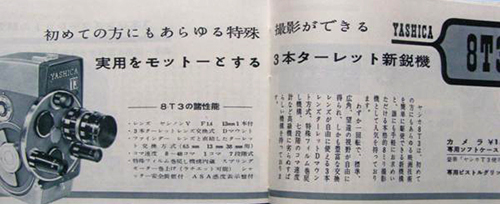
What makes this model stand out in the context of this website are the standard wide angle, normal and telephoto f/1.4 lenses branded “Yashinon-V Zunow” mentioned earlier under Lenses:
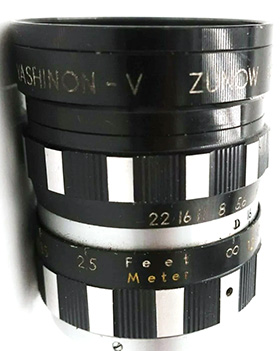 (Web image)
(Web image)
As Yashica sourced the original Yashica 8 model lenses from Zunow, finding the Zunow name on the lens is not surprising but it does only appear on the lenses of those two models plus the Yashica 8M even though it was advertised with the same spec Yashikor. The question remains whether any other lenses were made by Zunow for Yashica before it either shut its doors, or went in a new direction, in 1961. It seems to have still been developing its first zoom in 1961 so the early Yashica zooms were likely to have been from elsewhere. Tomioka's role in cine lenses is unknown but it didn't seem to offer any independently.
Two things that made the 8T3 different form the earlier twin turret cameras were the extra lens so that the full wide angle to telephoto range was covered and the use of turret finders in place of a universal zoom finder. Whilst this made the front of the camera look like a porcupine, the big advantage was that the angle of view of the finder lens was locked to the taking lens, with the early zoom finders, the finder slider on the side of the camera had to be manually changed - it could be forgotten, incorrectly set or accidentally moved:
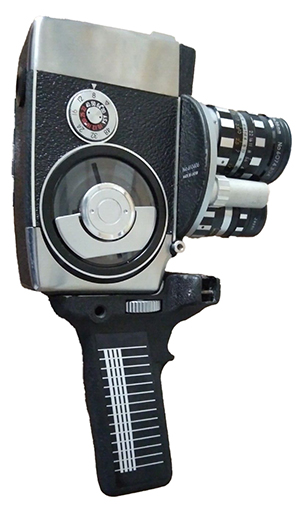
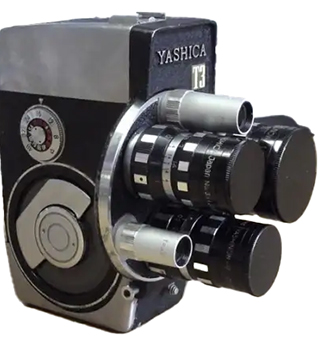 (Web images)
(Web images)
Left example shown with accessory hand grip. Similar ones were available for most models.
One camera in my database is from November 1959 and two are from January 1960. The 8T3 is the manual version of the auto exposure Yashica 8-EIII. Note, the 8-EIII features “Yashica Yashinon” f/1.8 lenses with no Zunow markings:
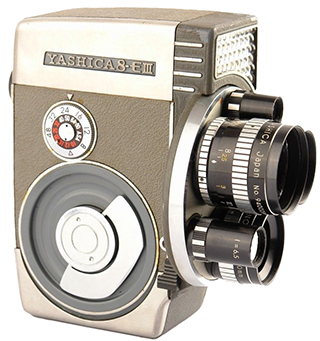 (Web image)
(Web image)
Yashica 8 EC with Zeika Lens
The Yashica 8 EC features a fixed zoom lens and connected zoom finder, both operated by a lever on the photographer's left side of the camera:
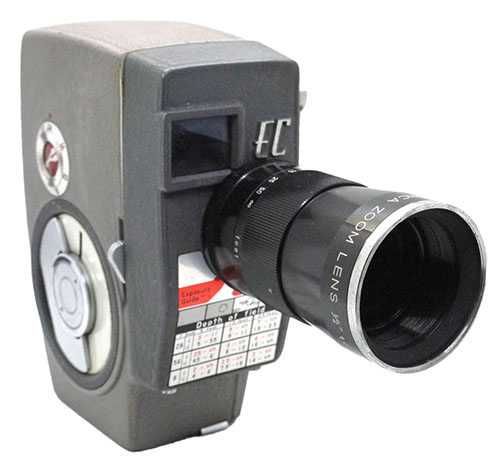 (Web image)
(Web image)
The lever is shown in the stored position, it pivots 180 degrees to the upright operating position:
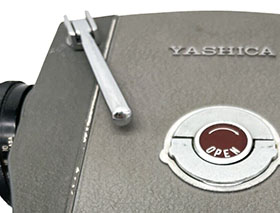 (Web image)
(Web image)
The Yashica 8 EC is fitted with a “Yashica Zoom Lens” but underneath it is “Zeika”, which is the name of Japanese cine lens maker Zeika Optical Company Ltd. (lens with filter attached):
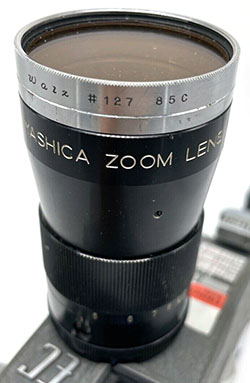
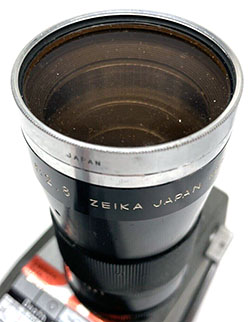 (Web images)
(Web images)
Yashica 8M with both Yashikor & Zunow Lenses
The Yashica 8M is Yashica's first battery powered model. It has an uncoupled selenium cell exposure meter, zoom finder and a twin turret with normal 13 mm lens only supplied. It was advertised in both Japanese and English language ads with the Yashikor 13 mm f/1.9 lens originally sold with the Yashica 8S:
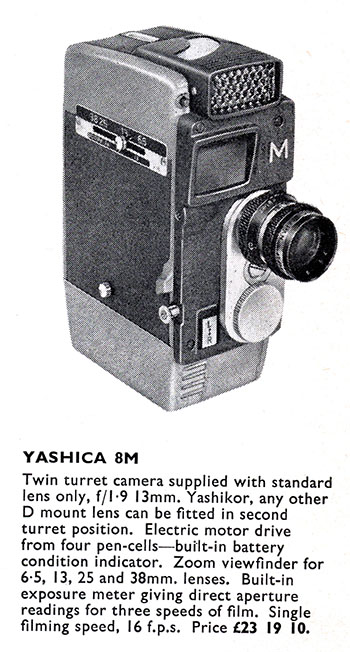 (Extracted from UK distributor Photax ad supplied by Neil Pawley)
(Extracted from UK distributor Photax ad supplied by Neil Pawley)
The earliest example found, serial number 63133x below left, has the advertised Yashikor mounted, eight later examples found with same spec Zunow (believed to be the same lens, see Yashica 8S) like the one below right:
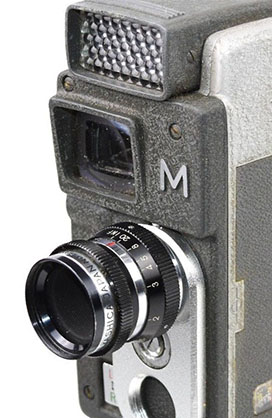
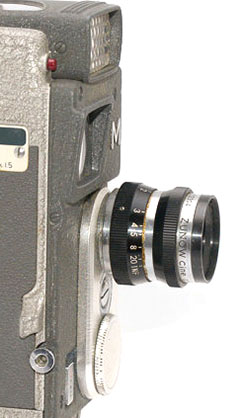 (Web images)
(Web images)
Yashica AIII, a Lens Oddity
The Yashica AIII, or perhaps 8AIII as advertised by distributor Photax UK, is an oddity in several different ways. The found examples are from 1961 and it seems to be based mainly on the 1960 Yashica 8M camera, see above. The AIII replaces the 8M twin turret and single lens supplied with a triple turret and three lenses but reverts to spring powered clockwork drive. The implementation seems to be more basic than earlier spring drive models which all feature a circular recess for the the clockwork drive winding key whereas on the AIII, the key sits proud of the leatherette of the side covering, probably an expediency when replacing the 8M's electric motor and battery compartment (the key's detailing and implementation is identical to that of the Yashica US, U-matic S, which also replaced the electric drive with a clockwork one). There is an inbuilt selenium cell exposure meter for manual metering, like the 8M, it is not linked to the aperture. Notwithstanding the tripple turret, the AIII appears to be a budget model compared to its peers. The three lenses are marked “Wizner”.
The following three images are of cameras from the collection of correspondent Neil Pawley who alerted me to the existence of the AIII and the other two variants further below:
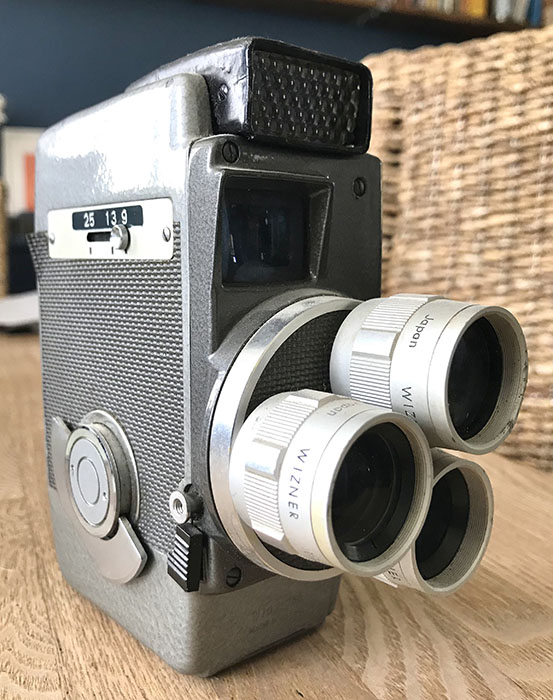
(Image courtesy of Neil Pawley)
Image below features the earlier Yashica 8M that the AIII is based on (shown with Yashica supplied Zunow 13 mm lens plus later fitted Fujita telephoto) and the related tripple turret Yashica 8C also based on the 8M body but fitted with turret finders and selenium cell based automatic exposure control:
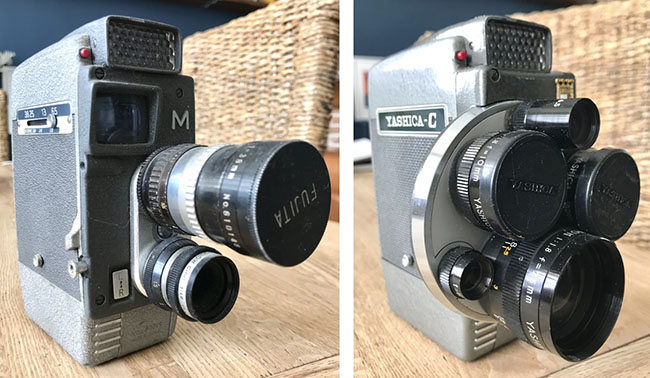
(Images courtesy of Neil Pawley)
The reverse side of an AIII showing its name plate:
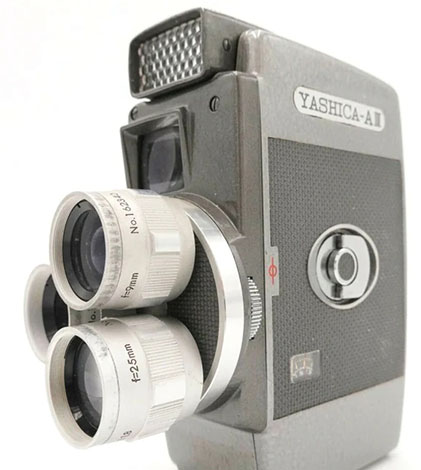 (Web image)
(Web image)
Wizner lenses are also found on the “Wizard 8” and “Valiant 8” movie cameras, which are identical to the AIII, and on the “Wizard W35”, “Valiant” and “Yashica Wizard” (a version of the Yashica 35W) 35 mm rangefinder cameras. More on the Yashica 35 page. Below are an example of the Wizard 8 on the left and the Valiant on the right:
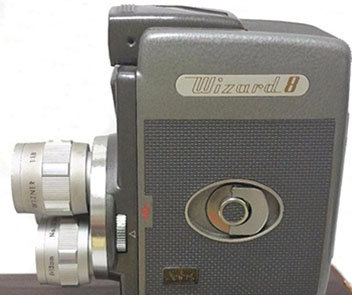
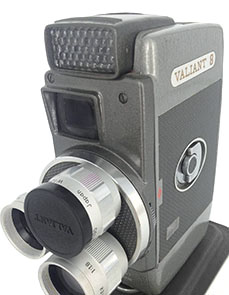
(Web images)
I don't know who the distributor of the Valiant 8 was but a Wizard 8 has been found with its Wizard box and guarantee papers with the distributor named as “Brother International Corporation Camera Division”. Brother was, and is, known as a manufacturer of sewing machines, amongst them well known “Wizard” models:
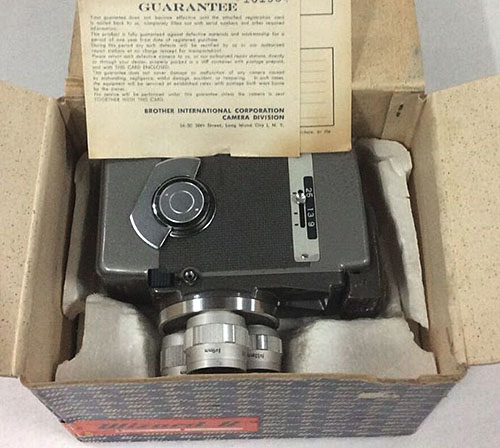 (Web image)
(Web image)
As it is extremely likely that the Wizner lenses take their name from “Wizard”, it is possible that this model was developed with Brother in mind from the outset. Whilst the Wizner lenses on the 35 mm cameras were likely to be rebranded Yashinons, the lenses on the 8 mm models match no other known lens on a Yashica 8 mm camera.
A recently added Yashica AIII to Neil Pawley's collection further supports the idea that the camera was developed for Brother. It was found with all three lens caps and user manual. The plastic lens caps have the “Wizard” name moulded on the front rather than “Yashica” whereas the Valiant 8 version above received its own “Valiant” named lens cap. The user manual is generic and features no branding on the cover, other than “9JC 1000”, or almost anywhere inside - images of the camera are displayed without nameplate. The one exception is the “Yashica” branded spool shown inside the camera. User manual cover, image inside without nameplate and image of spool:
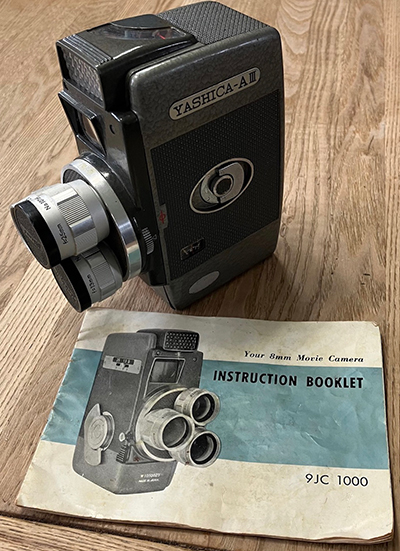
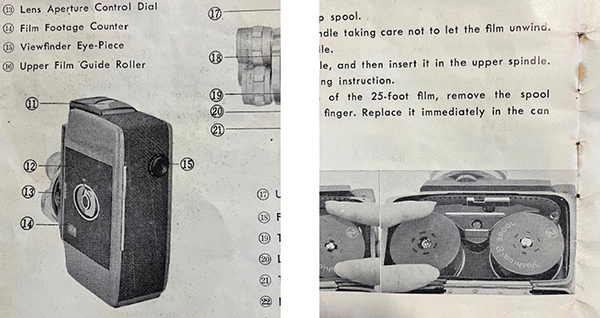
(Images courtesy of Neil Pawley)
The AIII is not a common model and may have been limited to certain markets. It was certainly advertised a number of times by the UK distributor Photax and appeared in a number of UK listings.
Yashica 8-ES, a Camera Oddity
The Yashica 8-ES seems like a relatively ordinary battery powered budget 8 mm camera with separate viewfinder, selenium cell based automatic exposure, single speed and fixed focus prime lens. The lens is a 13 mm f/1.8 Yashica Yashinon. What makes this camera stand out is that it was also sold as a “Soligor Automatic 8” with an “Argus Cinepar” lens, an “Argus Automatic 8” with the same Argus lens, a “Kohka Automatic 8” with “Kohkanon” lens and a “Rolls Automatic 8” with a “Rolls” lens. There may well be more that I am not aware of. Although there is variation in the plain barrel, all the lens specs are identical.
I'm not a collector of movie cameras, nor an expert in the field, and would not have made the connection that these cameras were all made by the same company except for Yashica 8 mm collector and aficionado, Neil Pawley, contacting me with some questions and comments about the Yashica AIII and its offspring and telling me about the 8-ES. I have already mentioned different lens barrels but the body shape of the Yashica 8-ES is subtly different to the others of which the Soligor, Argus and Rolls are the same as each other but the Kohka is different again. A layperson like myself might be dubious but the layout is basically the same, there is a similarity of looks, the specs are similar (the Yashica and Argus are both missing the switch-in filters of the others but the Argus is otherwise identical to the Soligor and Rolls). There is a similarity in detailing, inside and out including identical battery compartments and doors. Below are Neil Pawley's Yashica 8-ES, Soligor Automatic 8 and Kohka Automatic 8 (the filter dial is on the opposite side on the Kohka):
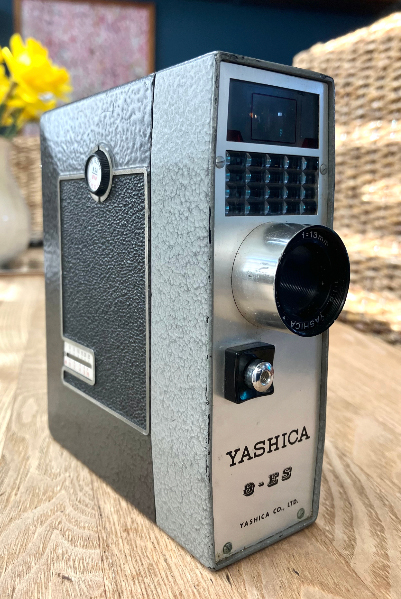
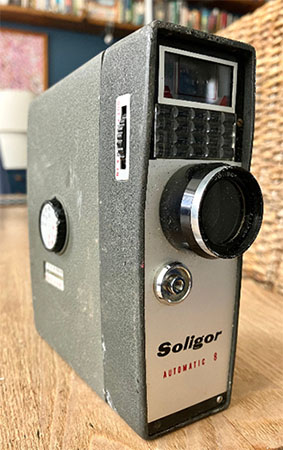
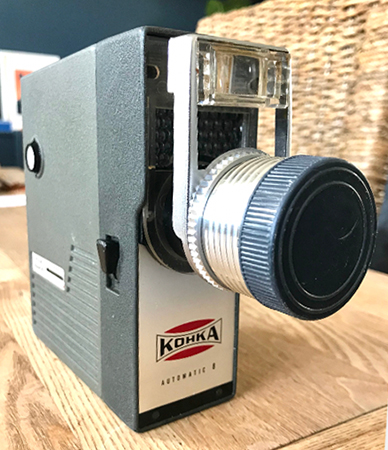
(Images courtesy of Neil Pawley)
The contraption on the front of the Kohka is a zoom adapter, I have photos of an identical one mounted on a Rolls which looks the same as Neil's Soligor.
The Umatics, the Pride of the Fleet
The Umatic models were the most full featured of Yashica's 8 mm range from 1961 to 1965, although within the group were also some models which were more budget than the others, e.g. the Yashica US (U-matic S) replaced the Yashica U (U-matic) battery with a clockwork drive and the Yashica U-G (Umatic-G) was reduced to a single speed and fixed focus. Below is a page from an Australian Yashica distributor, Swift and Bleakley, catalogue circa 1962 featuring the three models and their respective prices in Australian pounds:

Three features were consistent across the models, zoom lens, through the lens reflex viewfinder and auto exposure. Other features that were introduced (listed by model in the table above) include CdS cell automatic exposure, power zoom and auto threading of film.
Although the “U-matic” or “Umatic” name appeared on the front of the camera, the boxes and most of Yashica's documentation used the name on the side. The last known Umatic model, the 1964 auto loading Yashica UL, doesn't feature the Umatic name on the body but it appears in small print on its box, “Umatic-L”. There was one more Yashica 8 model, the 1965 auto threading “Yashica U5” which appears to closely resemble the UL. I'm not aware of what the difference is between “auto loading” and “auto threading”. I haven't seen any Yashica packaging or documentation for it so don't know if the Umatic name had been retired or not but clearly, the “U” in U5 suggests that it belongs to the same group.
Pictured below is the original Yashica U/U-matic:
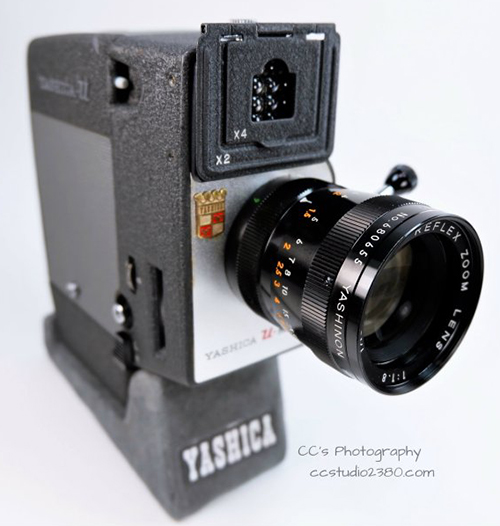
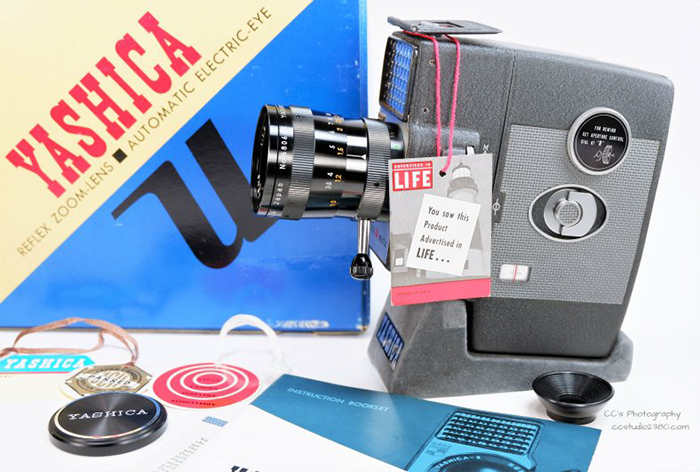
(Images courtesy of Chris Whelan)
Note the mask over the meter cell to manage sensitivity.
And the penultimate Yashica 8 mm, the Yashica UL/Umatic-L:
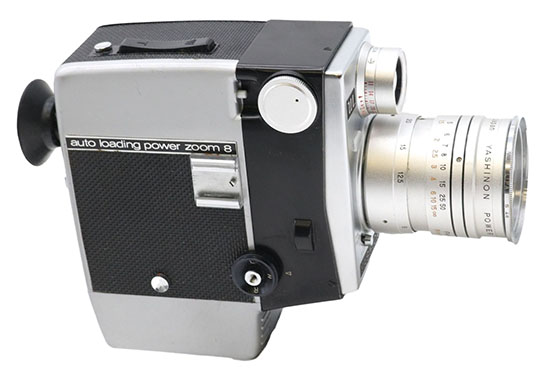 (Web image)
(Web image)
